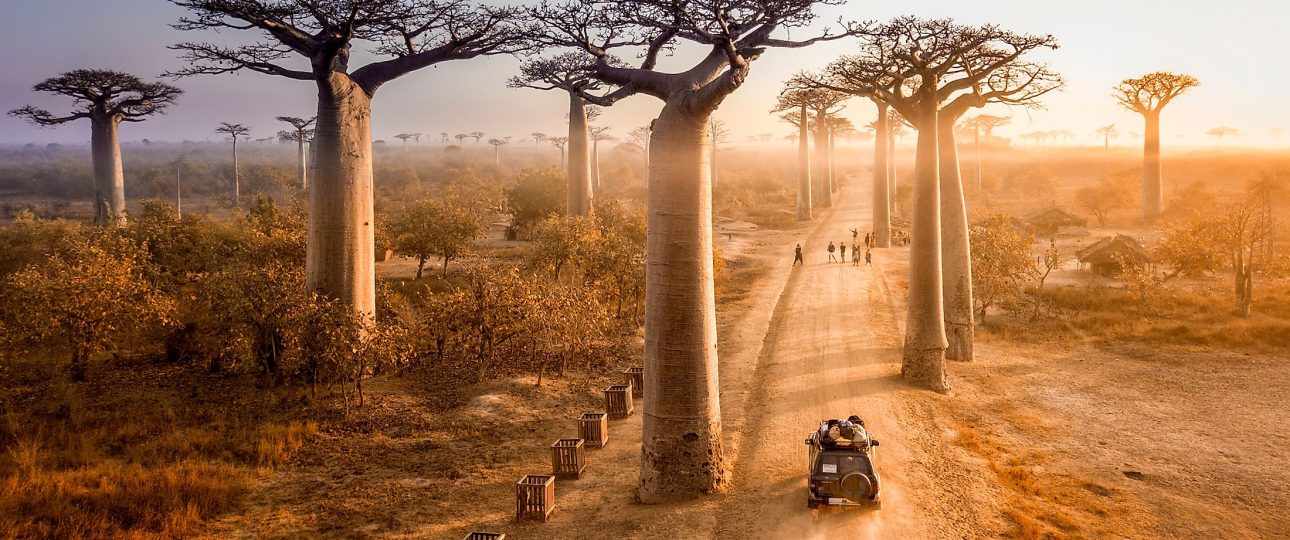Avenue of the Baobabs – Madagascar
Introduction
Welcome to the Avenue of the Baobabs, a remarkable destination in Madagascar known for its majestic baobab trees. This iconic stretch of road offers a glimpse into the island’s unique natural heritage, where ancient trees stand as sentinels of a bygone era. In this guide, we will delve into the allure of the Avenue of the Baobabs and provide practical tips for planning your visit.
What Makes the Avenue of the Baobabs Unique?
The Avenue of the Baobabs is home to a grove of 20 to 25 towering Adansonia grandidieri baobabs, which can reach heights of up to 30 meters (98 feet). These trees, known locally as renala or reniala, meaning “mother of the forest,” are endemic to Madagascar. They are remnants of the dense tropical forests that once covered the region. As the forests were cleared for agriculture, these resilient trees were preserved for their cultural significance and practical uses. Their unique appearance, with branches resembling roots, creates a striking landscape that captivates visitors.
Best Time to Visit
The ideal time to visit the Avenue of the Baobabs is during Madagascar’s dry season, from April to November. During these months, the weather is generally pleasant, and the sunsets are particularly stunning, casting long shadows across the landscape. However, daytime temperatures can be high, so it’s advisable to carry water and sunscreen to stay comfortable.
How to Get There
The nearest major city to the Avenue of the Baobabs is Morondava, which can be reached via domestic flights. From Morondava, the avenue is approximately 45 kilometers away, and the journey takes about an hour by car. You can hire a taxi or take a local bus to reach this iconic site. The route offers scenic views of the Madagascan countryside, adding to the adventure of your visit.
Exploring the Avenue
Upon arrival, exploring the Avenue of the Baobabs on foot is highly recommended. The main road, lined with these ancient trees, provides a picturesque walking path. Comfortable shoes and a camera are essential for capturing the beauty of the surroundings. For a deeper understanding of the area, consider hiring a local guide who can share fascinating stories about the baobabs and the local culture.
Conservation and Community Efforts
Since July 2015, the Avenue of the Baobabs has been recognized as a natural monument, yet the trees face threats from deforestation, agricultural encroachment, and fires. Despite its popularity, the area lacks visitor facilities, and local communities benefit minimally from tourism. Efforts by organizations like Fanamby aim to promote ecotourism and improve economic opportunities for residents, fostering both conservation and community development.
Nearby Attractions
Approximately 7 kilometers northwest of the avenue, you can find the Baobab Amoureux, two intertwined Adansonia za trees. According to local legend, these trees symbolize an eternal bond formed from an impossible love story. Visiting this site adds a layer of cultural richness to your journey.
Summary of Facts
- The Avenue of the Baobabs is located in Madagascar, featuring Adansonia grandidieri baobabs.
- The trees can grow up to 30 meters (98 feet) tall and are remnants of ancient forests.
- The best time to visit is during the dry season, from April to November.
- The closest major city is Morondava, accessible by domestic flights.
- The avenue is approximately 45 kilometers from Morondava, about an hour’s drive.
- Exploring on foot is recommended, with local guides offering valuable insights.
- Conservation efforts are underway to protect the trees and support local communities.



